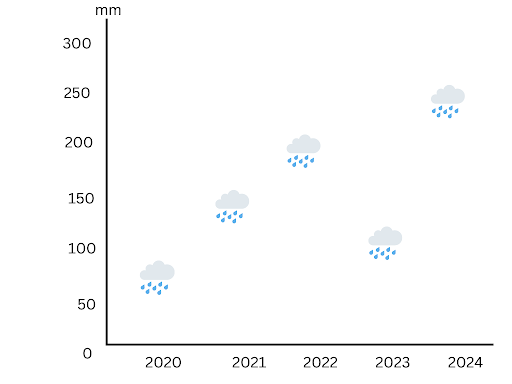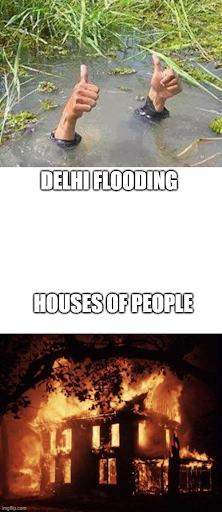How is Delhi Floods affecting people and climate? | Explained
- Student Journalist
- Sep 9, 2024
- 4 min read
IMD reports that half of Delhi's rain fell in just 3 days. Here is the story behind Impact of Delhi Floods on People and Climate.
Floods have affected the bustling city of Delhi. People are facing difficulty in terms of commuting to different places, school buses getting delayed and areas such as ITO, Anand Vihar, Delhi-NCR, Old Rajender Nagar experiencing waterlogging.
Starting in June 2024, the Delhi Floods have revealed the fragilities of urban infrastructure and highlighted the urgent need for improvement in flood management system.
How did the Delhi floods start?
A flood is the accumulation or overflow of water on dry land. It is usually caused by overflow of inland waters such as rivers, streams or dams. Rapid urbanization and poor stormwater infrastructure also do play a huge role in occurrence of a flood and extreme rainfall. Sometimes, it is preventable but other times, it can lead to fatal consequences such as loss of livestock, homelessness, water contamination in rivers and water-borne diseases like cholera and typhoid fever.
Delhi floods started on 28th June 2024, originating from heavy rainfall and release of Hathnikund Barrage in Haryana. The Yamuna River, which flows through Delhi, had breached its danger mark which is 205.33 m. The breach was caused by excessive inflow of water from the barrage, leading to flooding and water-logging in several low-lying areas of the capital.

Furthermore, on the same day, Delhi’s main Safdarjung station, a weather observatory reported 228.1 mm or 9 inches of rainfall in 24 hours which was the highest 24 hour-rainfall recorded in June in 88 years. Also, the areas around the Delhi Airport had 148.55 mm or 5.85 inches of rain for over 3-hours on 28th June compared to 101.7 mm or 4 inches of rainfall in June 2023.
The extreme event also has links with climate change. According to a NASA article, if the temperature rises by 1%, the amount of water vapor increases by 7%, leading to extreme rain events in fewer rainy hours and days. Additionally, raised river water levels, change in land cover through removal of vegetation can contribute towards extreme weather patterns and beginning of long-term climate change across the globe.
The fragility of the city's drainage system, accompanied with non-functionality of several pumps, lack of resources required for pumps, administration struggling to keep water levels normal, inadequate preparation and delay in response by the local government had also contributed towards the worsening of the floods.
The Impact
The extreme downpour caused disruption and chaos in the city. On the surface, it resulted in massive traffic jams, Terminal -1 airport roof collapse, blocked roads and submerged cars. However, the consequences were much more fatal for residents, laborers and commuters.
Areas near Yamuna river became severely flooded which resulted in displacement of residents and damage to property. One Delhi resident says, “ My house flooded with water and I had to leave my home. I have no place to live now.”
Moreover, according to a TOI report, at least 11 people died from extreme rain including 4 people who drowned in submerged underpasses and 1 person electrocuted due to touching a live wire submerged in the water-logged area of Bhajanpura, Delhi.

In case of laborers, many faced dangerous conditions such as being trapped in mud slush or wall collapses. The construction work was halted, economic losses due to floods and safety risks led to disruption in work and affected the livelihood of laborers. One laborer says, “The construction of the building was halted due to floods and now, I have no money to bear the daily expenses of my family.”
Commuters faced difficulties in commuting to places. For office-goers, the flood set up the stage for them to remain stuck in traffic jams and prolonged delays in reaching destinations. Some were forced to paddle through the knee-deep water to reach their workplace. Buses were delayed and metro stations remained closed which created problems for those relying on public transportation. Furthermore, the office buildings became overwhelmed with water seepages and power outages, leading to the inability to work on-site.
Anushka, an office-goer says, “Due to water-logging, I was stuck in a traffic jam for 4 hours and once I reached the office building, I found the building overflowing with water and I had to go back home.”
Vivek, another office-goer says, ”Now, I am planning to shift to another city which is not flood-prone as the constant flooding in Delhi is affecting my ability to commute and work at my office building.”
The challenges faced by different sets of people living in Delhi highlight the need for reforms in flood management, urban infrastructure, and disaster preparedness systems.
The Steps
Tackling the crisis, the MCD (Municipal Commission of Delhi) evacuated thousands of residents living in flood zones especially the ones living near Yamuna river. Traffic was rerouted from main roads to manage road congestion.
According to The New Indian Express report, authorities set up 44 relief camps and emergency shelters which were equipped with basic facilities like food, water and essentials and deployed 27 ambulances to support rescue and relief operations.
Furthermore, the Delhi government has set up a 24 x 7 control room at the PWD headquarters to oversee water logging and has worked towards restoring water supply from Wazirabad to Okhla, ensuring continuous water supply to the residents living in these areas.
Experts say that to tackle the flooding crisis, lakes and ponds should be dug to combat heavy rainfalls and prevent water scarcity. Also, public awareness regarding the importance of rainwater harvesting, increasing land cover and unclogging of drains should be done in order to avoid water flooding and massive disruptions in densely-populated cities like Delhi and Bengaluru.
Lastly, the Delhi floods have exposed the vulnerabilities of poor infrastructure and drainage systems, advocated for implementing climate policies that focus on tackling heatwaves, floods, ensure adequate preparedness and disaster awareness, and prevent the future occurrences of extreme weather events.
Written by Ambika Sharma
Ambika wrote this article as a participant of the Media-Makers Fellowship's July'24 cohort.
This article was adjudged the 'Best Climate Explainer' created in Week 3 of the program.


Comments